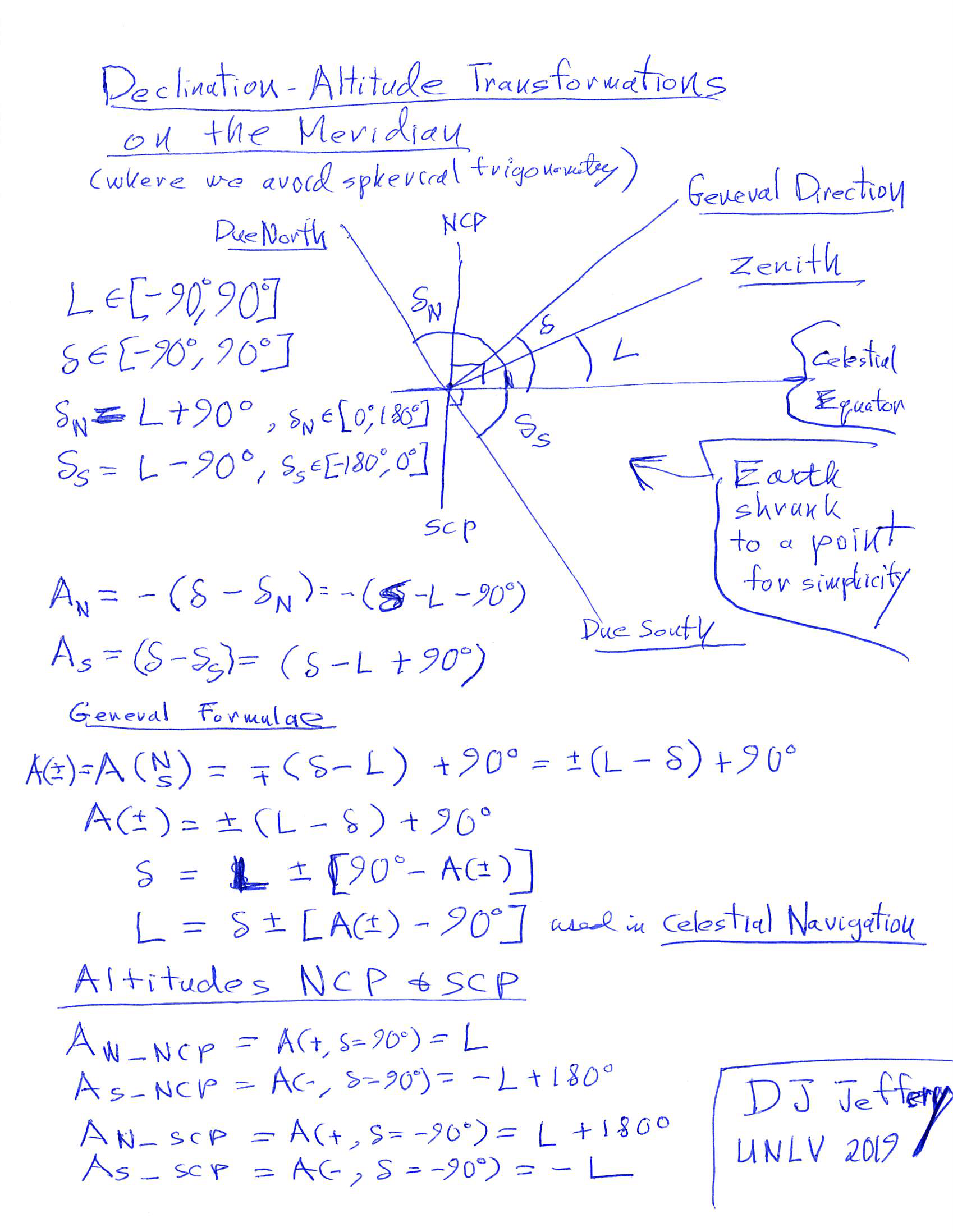- The general formulae
for
declination-altitude
conversions on the meridian
are relatively simple and have relatively simply
derivations.
The formulae and derivations are given Image 2.

- Image 2 Caption: To recapitulate the general formulae
from Image 2:
AN/S = (±)N/S(L - δ) + 90°
δ = L +(±)N/S(90° - AN/S)
L = δ +(±)N/S( AN/S - 90°)
- δ is declination.
- AN/S is altitude (upper case N or + is measured from due north and lower case S or - measured from due south.
- L is latitude.
- Nota bene: we count south latitude as negative.
- What if you want to determine declinations
from positions NOT on the meridian.
The you need to use spherical trigonometry
and the necessary formulae
and derivations are quite complex.
However, nowadays the computer
will do that for you.
- What are the special case formulae
for when the altitude
is for the
north celestial pole (NCP)
(δ_NCP = 90°)
and the south celestial pole (SCP)
(δ_SCP = -90°)?
From the general formulae:
- AN_NCP = L.
- AS_NCP = -L + 180°. For example, say you are at L = 45°, then the altitude of the NCP is 135° from due south which is obviously correct.
- AN_SCP = L + 180°. For example, say you are at L = -45°, then the altitude of the SCP is 135° from due north which is obviously correct.
- AS_SCP = - L. This is the mirror image of the special case AN_NCP = L. Note if you are in the Southern Hemisphere and count ount south latitude as positive (which is the normal convention), then the mirror image case is exactly as expected AS_SCP = L(south counted positive).
- In days of yore,
measurements of
declinations
from
transits
of the meridian
were very important in astrometry
(i.e., positional astronomy)
and
celestial navigation
since they could be done easily without
spherical trigonometry.
To determine declinations from positions NOT on the meridian. The you need to use spherical trigonometry and the necessary formulae and derivations are quite complex. However, nowadays the computer using spherical trigonometry easily converts horizontal coordinates to equatorial coordinates (and vice versa) and measurements at transits of the meridian are much less important than they were.
- In the
Northern Hemisphere,
the circumpolar sky
above/below the horizon
must be closer to the
NCP/SCP
than an angle equal to A_N_NCP = L.
From viewing Image 1, clearly the limiting
declinations
for the circumpolar sky obey
δ_(±)= ±(90° - L) ,
where the +/- case is lower/upper limit for declinations above/below the horizon. - What of the Southern Hemisphere?
Hm, tricky.
But we can make use of the
mirror reflection symmetry of the
celestial equatorial plane to write
-δ_(above/below)= ±[(90° - (-L)] -δ_(below/above)= ∓[(90° - (-L)] δ_(below/above)= ±[(90° - (-L)] δ_(±)= ±[(90° - (-L)] .where again southern latitudes are counted as negative and the +/- case is lower/upper limit for declinations below/above the horizon.
- The general formula is clearly
δ_(±)= ±(90° - |L|) ,
where the +/- case is lower/upper limit for circumpolar sky declinations, and +/- case is above/below the horizon for L > 0 and +/- case is below/above the horizon for L < 0. - At the equator (L=0),
there is NO
circumpolar sky.
At the poles (L=±90°)
all the sky is
circumpolar sky.
- One can write down some useful
formulae for
the circumpolar sky:
f_c = 1 - cos(L) : fraction of the sky that is circumpolar f_s = (1/2)*(1 - cos(L)) : fraction of the sky that is circumpolar and above/below the horizon f_n = cos(L) : fraction of the sky that is non-circumpolar
which follow from the integral
[1/(4π)]*2*2*π* ∫μ1dμ = 1 - μ = 1 - cos(90-(90-|L|)) = 1 - cos(L) .
- The fraction of sky that is
non-circumpolar
can all be seen from
any latitude, but
only half at any time in the day.
The Earth
occults the other half.
The rotation of Earth allows you to
see the whole
non-circumpolar sky over the course of a day.
The above formulae for the fractions of sky have been used to construct Table: The Circumpolar Sky given below.
_____________________________________________________________________ Table: The Circumpolar Sky _____________________________________________________________________ Latitude N/S f_c f_s f_n f_n exact comment (degrees) _____________________________________________________________________ 0 0.0000 0.0000 1.0000 1 on equator 30 0.1340 0.0670 0.8660 sqrt(3)/2 36 0.1910 0.0955 0.8090 ... in Las Vegas 60 0.5000 0.2500 0.5000 1/2 90 1.0000 0.5000 0.0000 0 at North Pole or South Pole _____________________________________________________________________ Reference: CAC-8--9 _____________________________________________________________________